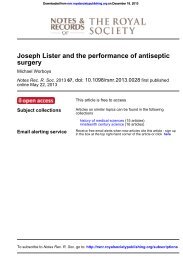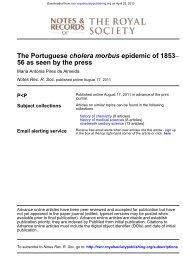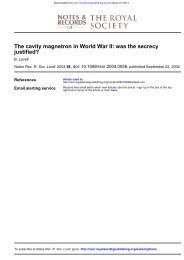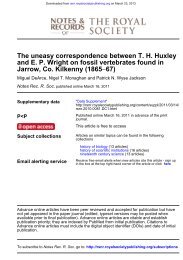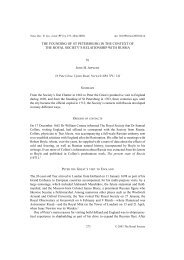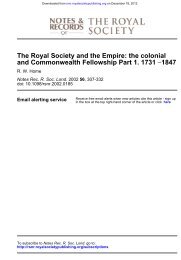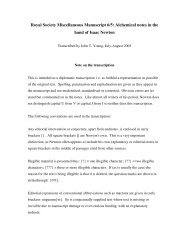an unpublished letter from henry oldenburg to johann heinrich rahn
an unpublished letter from henry oldenburg to johann heinrich rahn
an unpublished letter from henry oldenburg to johann heinrich rahn
Create successful ePaper yourself
Turn your PDF publications into a flip-book with our unique Google optimized e-Paper software.
Downloaded <strong>from</strong><br />
rsnr.royalsocietypublishing.org on December 6, 2012<br />
250 Noel Malcolm<br />
JOHANN HEINRICH RAHN<br />
Joh<strong>an</strong>n Heinrich Rahn (1622–76) was a member of a prominent Zurich family: his father<br />
served as a city councillor for more th<strong>an</strong> 50 years, <strong>an</strong>d was Bürgermeister (Mayor) of<br />
Zurich <strong>from</strong> 1655 until his death in 1669. Rahn probably acquired his special interest in<br />
mathematics <strong>from</strong> his uncle Joh<strong>an</strong>n Georg Werdmüller, who was the engineer in charge<br />
of the city’s fortifications. He himself was appointed a ‘Schützenmeister’, which me<strong>an</strong>t<br />
that he supervised shooting practice, <strong>an</strong>d a ‘Zeugherr’, responsible for military supplies<br />
<strong>an</strong>d artillery. 3 His mathematical interests were stimulated in 1654 by the arrival in Zurich<br />
of John Pell, the former Professor of Mathematics at Amsterdam <strong>an</strong>d Breda (<strong>an</strong>d future<br />
FRS), who served as Cromwell’s envoy <strong>to</strong> the Protest<strong>an</strong>t c<strong>an</strong><strong>to</strong>ns of Switzerl<strong>an</strong>d <strong>from</strong><br />
May 1654 <strong>to</strong> June 1658. The first sign of his connection with Pell is a <strong>letter</strong> he sent, dated<br />
4 November 1654, enclosing a short mathematical demonstration <strong>an</strong>d th<strong>an</strong>king Pell for<br />
the gift of a copy of one of Pell’s publications, his compilation of texts refuting the<br />
D<strong>an</strong>ish circle-squarer Longomont<strong>an</strong>us. 4 What further contacts they had over the next two<br />
years is not known, but at some time in early 1657 Rahn beg<strong>an</strong> <strong>to</strong> receive regular weekly<br />
tu<strong>to</strong>rials <strong>from</strong> Pell. As John Aubrey would later write (summarizing what Pell had <strong>to</strong>ld<br />
him), ‘Rhonius [the latinized version of ‘Rahn’] was D r Pell’s scholar at Zurich, <strong>an</strong>d<br />
came <strong>to</strong> him every friday night’; Pell himself would refer <strong>to</strong> Rahn as his ‘disciple’ <strong>an</strong>d<br />
would retain ‘coppies of the most considerable papers that he wrought in my presence or<br />
that I gave him <strong>to</strong> tr<strong>an</strong>scribe’. 5<br />
In early 1658 Rahn was appointed ‘L<strong>an</strong>dvogt’ (provincial governor) of Kyburg, a district<br />
at the northern edge of the c<strong>an</strong><strong>to</strong>n of Zurich; writing <strong>to</strong> Pell <strong>from</strong> there on 3 March<br />
1658, he remarked that his heavy administrative workload prevented him <strong>from</strong> spending<br />
<strong>an</strong>y time on mathematics, but said that he had the consolation of remembering ‘how<br />
m<strong>an</strong>y very delightful hours’ they had spent <strong>to</strong>gether. 6 Nevertheless, during the next year<br />
he somehow found time <strong>to</strong> compose the Germ<strong>an</strong>-l<strong>an</strong>guage textbook on algebra that<br />
would make him famous: Teutsche Algebra, oder algebraische Rechenkunst, zusamt<br />
ihrem Gebrauch (Zurich, 1659). This work was heavily indebted <strong>to</strong> Pell, <strong>an</strong>d it was a debt<br />
that Rahn was happy <strong>to</strong> acknowledge (though, probably in deference <strong>to</strong> Pell’s own habitual<br />
modesty, without mentioning his name): Rahn explained in his preface that ‘in the<br />
solutions, <strong>an</strong>d in the arithmetic <strong>to</strong>o, I make use of a completely new method … which I<br />
first learned <strong>from</strong> <strong>an</strong> eminent <strong>an</strong>d very learned person.’ This new method, he explained,<br />
consisted in ‘a triple margin’—Pell’s system of presenting the working-out of a problem<br />
in three columns. But that was not the only thing owed <strong>to</strong> Pell in this volume: Rahn also<br />
introduced the division sign (which Pell had invented), <strong>an</strong>d in a section on squaring the<br />
circle he presented the theorem Pell had defended in his controversy with<br />
Longomont<strong>an</strong>us. 7<br />
When Rahn’s book was published, Pell was back in London, leading a somewhat<br />
obscure existence without <strong>an</strong>y public or academic position. He was no longer in <strong>to</strong>uch<br />
with Rahn, but in November 1660 he did receive a copy of Rahn’s book <strong>from</strong> his friend<br />
Theodore Haak (the Germ<strong>an</strong>-born scholar <strong>an</strong>d tr<strong>an</strong>sla<strong>to</strong>r, a m<strong>an</strong> of wide scientific interests,<br />
who would be elected FRS in the following year). 8 Other copies evidently found<br />
their way <strong>to</strong> Engl<strong>an</strong>d, for in the early 1660s two separate tr<strong>an</strong>slations of it were under-



